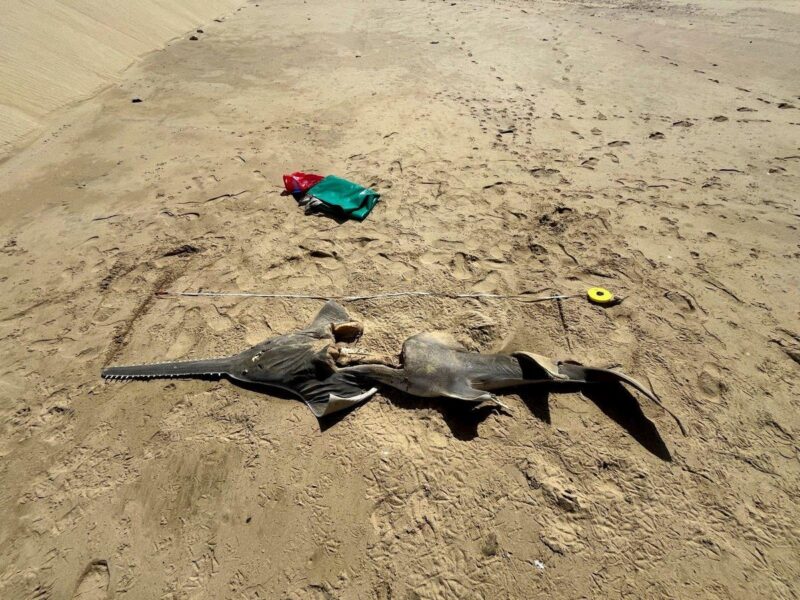On 19 September 2025, a single sawfish, thought to be locally extinct in South Africa, was found along the Eastern Cape coast. This animal, likely to be the Largetooth sawfish (Pristis pristis) was photographed by local resident Mike Vincent, after he found it dead on the beach south of the Birah River Mouth. He reported it to Kevin Cole, from the East London Museum, who immediately recognised the iconic rostrum, and went to investigate and take samples.
Kevin Cole – East London Museum, and Mike Vincent
At first glance, Mike Vincent thought he was staring at… well, who knows what. Driftwood, maybe? The tide low and the shape on the sand south of the Birah River Mouth seemed too strange to be anything living. But as he stepped closer, the truth sank in: it was an animal, alright. Vincent reported it to Kevin Cole, from the East London Museum, who immediately recognized the unmistakable rostrum of a sawfish — a creature many had assumed was gone from South African waters for good. That moment was more than just an unusual find at the beach. It was historic. Sawfish haven’t been recorded in the region since the late 1990s, making Vincent’s discovery a stunning return for one of the ocean’s rarest residents. Cole, a veteran natural historian, rushed to the site to collect samples as news of the find quickly rippled through the conservation community.
Sawfish are globally recognized as the most endangered elasmobranchs, a group that includes sharks and rays. Their appearance is unmistakable: a flattened body topped with a long snout lined by teeth that resemble a jagged saw blade. Despite their fearsome look, sawfish are rays, not sharks and their rostra serve as both weapon and sensory organ. With it, they can detect faint electrical signals and slash through schools of fish with deadly precision. Two species are known to occur in South Africa, the green sawfish (Pristis zijsron) and the largetooth sawfish (Pristis pristis). Both have been pushed to the brink by habitat destruction and unsustainable fishing methods. Estuaries, once teeming nurseries for young sawfish, have been choked by development, pollution and altered river flows. Fishing gear such as gillnets and trawls have also been devastating, ensnaring sawfish that cannot escape once entangled. The last confirmed record was in 1999, when a sawfish was released alive from KwaZulu-Natal Shark Nets.
Since then, they seemed to vanish, and local marine biologists have feared the species might be regionally extinct.
The East London sighting may not indicate a full return, but it cracks open a door long thought sealed. Even one individual suggests the possibility that remnants of a population remain, hidden in estuaries or coastal waters. This discovery is also a call to double down on protecting habitats that could still harbor survivors, as the Facebook group Sharks Under Attack reminds us: “Let’s celebrate this moment, but also recommit to restoring our estuaries, which are critical habitats for these species, as well as protecting our marine heritage.” The importance of estuaries cannot be overstated; these brackish zones where rivers meet the sea are cradles of biodiversity, sheltering juvenile fish and supporting migratory birds, crustaceans and countless other species. For sawfish, estuaries are essential. Safeguarding them through restoration projects, stricter pollution controls and sustainable development offers a chance not just for sawfish survival but for healthier marine ecosystems overall.
The largetooth sawfish (Pristis pristis, syn. P. microdon and P. perotteti) is historically widespread in marine, estuarine and freshwater waters of the Eastern Atlantic, Western Atlantic, Eastern Pacific and Indo-West Pacific – with 4 genetically distinct populations. It is now extinct or severely depleted in numbers in much of its former range.
getty
Sawfish have always occupied an almost mythical status in the ocean. With their sword-like rostra and massive size, they sort of feel like relics from another era. To see one suddenly appear on a South African beach after decades of silence is both eerie and electrifying, a reminder that the ocean still holds surprises. But the excitement that comes with this sighting must also be balanced with realism. Sawfish have slow life histories, meaning they take years to reach sexual maturity, give birth to relatively few offspring and require stable conditions to rebuild populations. A single washed-up carcass is not proof of recovery. But what is does provide is evidence that they are not entirely gone — and that is enough to fuel both hope and urgency. Conservation programs that focus on protecting estuaries, regulating fishing methods and restoring natural river flows are essential to giving sawfish a chance at long-term survival.
Without Vincent’s sharp eye and quick action, this event might have passed unnoticed, leaving researchers without critical data. Citizen observations like this one not only help scientists fill gaps in knowledge, but illustrates how public awareness and engagement can contribute to meaningful conservation work. With tools like smartphones and direct lines to museums or research organizations, public involvement has never been more impactful. By reporting unusual sightings, collecting photographs or helping researchers access remote areas, citizens can play a direct role in preserving biodiversity! In the case of sawfish, timely reporting is critical because researchers can take samples that inform population genetics, track threats and shape recovery strategies. It has been asked that if anyone in South Africa has seen this species recently or has caught one, to please report this information to Bernadine ([email protected]), Kevin ([email protected]) or Geremy ([email protected]).
For South Africa, the challenge now is to treat this as more than a one-off curiosity. It should be a spark that ignites stronger conservation action, from estuary restoration to stricter fishing regulations. Protecting sawfish means protecting entire ecosystems and the ripple effects extend to every community that relies on healthy oceans. South Africa’s coastal communities have an opportunity to become stewards of their marine heritage as protecting sawfish is not just about one species; it is about safeguarding the network of life that depends on estuaries, tidal flats and nearshore habitats. In conservation, hope is often the first step toward action, and sometimes, a single sighting can inspire decades of change.









